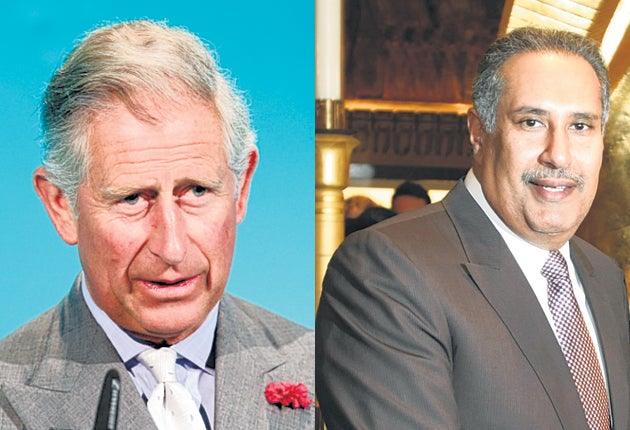Sorry for interfering, but this building is too brutal, Prince wrote to Qatari sheikh
Embarrassment for Charles as letter to Sheikh criticising Chelsea Barracks development is published

Your support helps us to tell the story
From reproductive rights to climate change to Big Tech, The Independent is on the ground when the story is developing. Whether it's investigating the financials of Elon Musk's pro-Trump PAC or producing our latest documentary, 'The A Word', which shines a light on the American women fighting for reproductive rights, we know how important it is to parse out the facts from the messaging.
At such a critical moment in US history, we need reporters on the ground. Your donation allows us to keep sending journalists to speak to both sides of the story.
The Independent is trusted by Americans across the entire political spectrum. And unlike many other quality news outlets, we choose not to lock Americans out of our reporting and analysis with paywalls. We believe quality journalism should be available to everyone, paid for by those who can afford it.
Your support makes all the difference.The Prince of Wales suffered further embarrassment yesterday over his intervention in a high-profile planning proposal which allegedly led to the withdrawal of the £3bn project when the full text of his self-avowedly "interfering" letter to the Prime Minister of Qatar was released.
The heir to the throne, who has found himself at the heart of an £81m breach of contract dispute over the development of the Chelsea Barracks, penned the impassioned letter to Sheikh Hamad bin Jassim al Thani, who is also head of the Middle Eastern state's vast sovereign wealth fund, to complain about the "Brutalist" proposals for the prime central London site.
The letter has been partially cited in proceedings at the High Court between Qatari Diar, the development company headed by Sheikh Hamad, and its former partner on the Chelsea Barracks project, CPC Group, run by the Monaco property tycoon Christian Candy.
But the court yesterday ordered the private correspondence to be made public, revealing the full nature of the Prince's plea to a fellow royal – complete with heavy underlinings added by the Prince in his own hand with his fountain pen to emphasise his views.
The text, typed on headed Clarence House paper in March last year, was pored over by lawyers for Mr Candy, who claim that the Qataris breached their contract to pursue the Modernist design for the site by the architect Lord Rogers when they withdrew their planning application at the last moment last summer. Qatari Diar has claimed that the application was pulled back due to planning and commercial concerns and was not related to the Prince's lobbying of Sheikh Hamad and the Emir of Qatar, who eventually gave the order for the scheme to be withdrawn.
In his letter, the Prince characteristically fails to pull his punches on architectural matters, saying he feels compelled to write to his Middle Eastern confrère to highlight the "destruction" of many parts of London "with one more 'Brutalist' development after another". Describing such schemes as a "gigantic experiment with the very soul of our capital city", the Prince suggests that it is time for "old-fashioned" values of Georgian architecture in cities such as Bath and Edinburgh to be restored.
He wrote: "Such environments are based on the 'old-fashioned' – I would call them timeless – virtues of squares, mansion blocks and terraces, all of which can be shown to provide comparable density to that achieved by high-rise blocks."
Lord Rogers drew up his glass and steel design of multistorey blocks in a carefully sculpted landscape after Qatari Diar spent almost £1bn to buy the Chelsea Barracks site, a sought-after location hitherto occupied by the Coldstream Guards and the Scots Guards, from the Ministry of Defence.
Complaining that "my heart sank" when he saw the proposed plans, the Prince appears to admit that he is "interfering" in the development and puts forward an alternative scheme based on a sketch by his favourite architect, Quinlan Terry, which he says would have the added benefit of uncovering the river Westbourne, a long-buried tributary of the Thames.
The Prince wrote: "I am so sorry to have to write to you on this subject, and thus to be so interfering, but it is a site of great importance in London and therefore deserves something that is appropriate to its context." Wielding his underlining fountain pen with ever more urgency, the Prince emphasises how he is "deeply" concerned about the development before adding he would "urge" Sheikh Hamad to reconsider the scheme "before it is too late".
The hearing before Mr Justice Vos, who has reserved judgment, was told that the Qataris initially gave no sign that they would accede to the Prince's representations. In a reply to Clarence House, written in June last year, Sheikh Hamad wrote: "We believed that in choosing a leading British architect, a super-high end residential developer... we have met our aim."
When the Prince's alleged role in the project's demise became known last year, architects including Frank Gehry, Lord Foster, Renzo Piano and Pierre de Meuron criticised him for "using his privileged position" to "skew" the democratic planning process.
Last week it was revealed that the Prince spoke to the deputy mayor of London about his concerns prior to the proposal being put before planners.
Clarence House declined to comment on the letter. Previously a spokesman for the Prince has said: "We have repeatedly said that the Prince of Wales, like anybody else, has the right to express his opinion."
Join our commenting forum
Join thought-provoking conversations, follow other Independent readers and see their replies
Comments